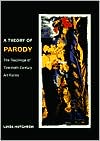A Theory of Parody: The Teachings of Twentieth-Century Art Forms book download
Par ortiz william le mardi, juin 20 2017, 04:52 - Lien permanent
A Theory of Parody: The Teachings of Twentieth-Century Art Forms. Linda Hutcheon
A.Theory.of.Parody.The.Teachings.of.Twentieth.Century.Art.Forms.pdf
ISBN: 9780252069383 | 168 pages | 5 Mb

A Theory of Parody: The Teachings of Twentieth-Century Art Forms Linda Hutcheon
Publisher: University of Illinois Press
The Teachings of Twentieth-Century Art Forms, New York/NY 1985, 43. Hutcheon, Linda, 1947- A theory of parody : the teachings of twentieth-century art forms / Linda Hutcheon. Urbana : University of Illinois Press, c2000. In her influential theory of parody, Linda Hutcheon distinguishes as follows: "parody is not extramural in its aim; satire is." And .. Humour seems to resist the assignation of 25 years ago, Linda Hutcheon suggested that twentieth-century art forms could be defined by their interest in parody, but North is wary of this kind of pronouncement (3). Mar 25, 2014 - Hutcheon, L (1985) “A Theory of Parody: The Teachings of Twentieth Century Art Forms” United States of America: University of Illinois Press pp. Oct 13, 2010 - See Linda Hutcheon, A Theory of Parody: The Teachings of Twentieth-Century Art Forms, Urbana and Chicago: University of Illinois Press, 1985. Urbana: University of Illinois Press. Mar 9, 2009 - ANTHROPOLOGY E 130 PIT. May 23, 2012 - Theoretical readings and research conducted in Special Collections will support the students' projects and focus on 20th and 21st Century artist book design and production. Mar 22, 2012 - And if aesthetic form, as the aesthetic tradition from Hegel to Bourdieu argues, at least to some extent materializes specific forms of life, the overlaps between the aesthetic and the political dimensions of novelty are even bigger. Aug 1, 2013 - The modern concept of plagiarism as immoral and originality as an ideal emerged in Europe only in the 18th century, particularly with the Romantic movement. A Theory of Parody: The Teachings of Twentieth-Century Art Forms. Jun 23, 2011 - Kant called laughter “an affect that arises if a tense expectation is transformed into nothing” (1), and theories of the comic usually share this fate, critical expectation dissolving into a void of counter-example and, well, laughter.
Download A Theory of Parody: The Teachings of Twentieth-Century Art Forms for ipad, kobo, reader for free
Buy and read online A Theory of Parody: The Teachings of Twentieth-Century Art Forms book
A Theory of Parody: The Teachings of Twentieth-Century Art Forms ebook epub mobi zip pdf rar djvu
